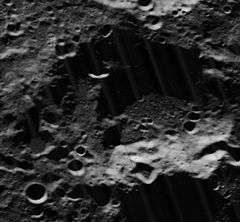Niepce (crater)
Niepce is a crater on the far side of the Moon. It lies in the high northern latitudes, just behind the north-northwestern limb. Less than a crater diameter to the north is the crater Merrill, and just to the west is Mezentsev. Farther to the south-southeast is Nöther.
 Oblique Lunar Orbiter 5 image, facing west | |
| Coordinates | 72.7°N 119.1°W |
|---|---|
| Diameter | 57 km |
| Depth | Unknown |
| Colongitude | 120° at sunrise |
| Eponym | J. Nicéphore Niépce |
This is a worn crater formation with rim features that have been softened and rounded by subsequent deposits of ejecta. Attached to the eastern rim is the satellite crater Niepce F, and the inner wall of Niepce is wider along this edge. The remaining interior floor is relatively level, and offset toward the western side. There are several small impacts on the floor, the largest being a small craterlet along the north-northeastern edge. Just along the southwest rim edge is a small, teardrop-shaped crater that was likely created by a low angle impact.
Satellite craters
By convention these features are identified on lunar maps by placing the letter on the side of the crater midpoint that is closest to Niepce.
| Niepce | Latitude | Longitude | Diameter |
|---|---|---|---|
| F | 72.5° N | 113.5° W | 44 km |
Name
The crater is named after Nicéphore Niépce who is widely credited for having taken the first ever permanent photograph in 1825.
References
- Andersson, L. E.; Whitaker, E. A. (1982). NASA Catalogue of Lunar Nomenclature. NASA RP-1097.CS1 maint: ref=harv (link)
- Blue, Jennifer (July 25, 2007). "Gazetteer of Planetary Nomenclature". USGS. Retrieved 2007-08-05.CS1 maint: ref=harv (link)
- Bussey, B.; Spudis, P. (2004). The Clementine Atlas of the Moon. New York: Cambridge University Press. ISBN 978-0-521-81528-4.CS1 maint: ref=harv (link)
- Cocks, Elijah E.; Cocks, Josiah C. (1995). Who's Who on the Moon: A Biographical Dictionary of Lunar Nomenclature. Tudor Publishers. ISBN 978-0-936389-27-1.CS1 maint: ref=harv (link)
- McDowell, Jonathan (July 15, 2007). "Lunar Nomenclature". Jonathan's Space Report. Retrieved 2007-10-24.CS1 maint: ref=harv (link)
- Menzel, D. H.; Minnaert, M.; Levin, B.; Dollfus, A.; Bell, B. (1971). "Report on Lunar Nomenclature by the Working Group of Commission 17 of the IAU". Space Science Reviews. 12 (2): 136–186. Bibcode:1971SSRv...12..136M. doi:10.1007/BF00171763.CS1 maint: ref=harv (link)
- Moore, Patrick (2001). On the Moon. Sterling Publishing Co. ISBN 978-0-304-35469-6.CS1 maint: ref=harv (link)
- Price, Fred W. (1988). The Moon Observer's Handbook. Cambridge University Press. ISBN 978-0-521-33500-3.CS1 maint: ref=harv (link)
- Rükl, Antonín (1990). Atlas of the Moon. Kalmbach Books. ISBN 978-0-913135-17-4.CS1 maint: ref=harv (link)
- Webb, Rev. T. W. (1962). Celestial Objects for Common Telescopes (6th revised ed.). Dover. ISBN 978-0-486-20917-3.CS1 maint: ref=harv (link)
- Whitaker, Ewen A. (1999). Mapping and Naming the Moon. Cambridge University Press. ISBN 978-0-521-62248-6.CS1 maint: ref=harv (link)
- Wlasuk, Peter T. (2000). Observing the Moon. Springer. ISBN 978-1-85233-193-1.CS1 maint: ref=harv (link)